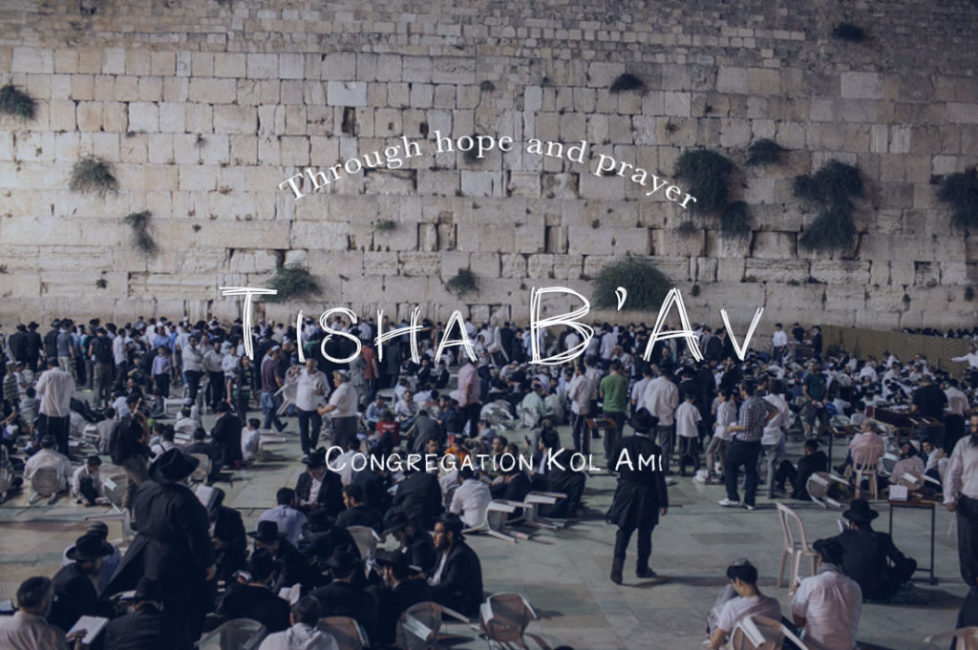
Tisha B’Av, the ninth (Tisha) of Av, commemorates the destruction of both Temples (the first in 586 BCE and the second in 70 CE).
A brief history of the building and destruction of the First and Second Temples.
The First Temple in Jerusalem was constructed during the reign of King Solomon (965 b.c.e.–925 b.c.e.). Solomon’s father, King David, had wished to build the Temple, but was not allowed to do so. The Bible relates that God disqualified David because of his many military campaigns. The Temple was to be a holy place, a place of peace. Therefore, only a king who had not shed blood could bring it into being. Thus, Solomon, whose Hebrew name was Shlomo (from shalom, peace), inherited this sacred task.
Solomon built the First Temple with the assistance of King Hiram of Tyre. Hiram sent his Phoenician artists and builders magnificent stone from his nation’s quarries and the beautiful cedars of Lebanon to aid in the task.
The finished Temple was an awesome structure. Situated on a mountain 2/500 feet high, it had courtyard, a sanctuary, and a small room called the Holy of Holie, entered only once a year by the high priest. It was in the Temple that the kohanim (priests) offered the ancient sacrifices on behalf of the people, assisted by the Levites.
In 586 b.c.e., the Babylonian army surrounded Jerusalem. Led by their general, Bebuchadnezzar, they broke into the city and conquered it. Then, on the Ninth of Av, they destroyed the Temple. The Jews were sent into exile, crushed and despondent. According to some scholars, the prophet Jeremiah, grieving for the Temple, composed Psalm 137, in which he wrote: “By the waters of Babylon, we lay down and wept for thee Zion.” A people who had grounded their entire religious system in a priestly Temple structure suddenly had it torn away from them.
Even as he mourned, Jeremiah still had hope. He told the people that they would one day return to Jerusalem and rebuild the Temple. He was correct. Some sixty years later, Persia conquered Babylonia, and the Persian King Cyrus allowed the Jews to return home. They rebuilt the Temple but it was not nearly as magnificent as Solomon’s Temple had been. Still, the Jews rejoiced, for once again they had an opportunity to be led by their priests and to offer sacrifices in their holiest site. It was this rebuilt Temple that King Antiochus defiled in 168 b.c.e., and which the Maccabees reconsecrated three years later. But the Building of the Second Temple was yet to come.
The Second Temple was enhanced and expanded during the first century b.c.e by King Herod, one of the cruelest rulers in Jewish history. Deciding that the rebuilt Temple was not to his liking, Herod decided to expand it. He partially leveled the previous site, then oversaw the construction of a Temple that rivaled that of Solomon’s in grandeur.
Herod had intended to continually add new structures to the Temple grounds, but the work was never completed. In 70 c.e., Roman legions, led by the General Titus, conquered Jerusalem and destroyed the Temple. It was the Ninth of Av. Once again, the Jews were sent into exile, this time to Rome.
Some historians have expressed doubt that the actual destruction of both Temples occurred on the Ninth of Av, but there is no disputing the fact that the day became a symbol of Jewish tragedy. The synagogue ultimately replaced the Temple. [New forms of worship and religious leadership were created.] But Jew continued to hope and pray that the Temple would be restored. The prayer book and songs expressed this yearning, and Tishah B’Av became a vehicle for expressing that deep sorrow.
